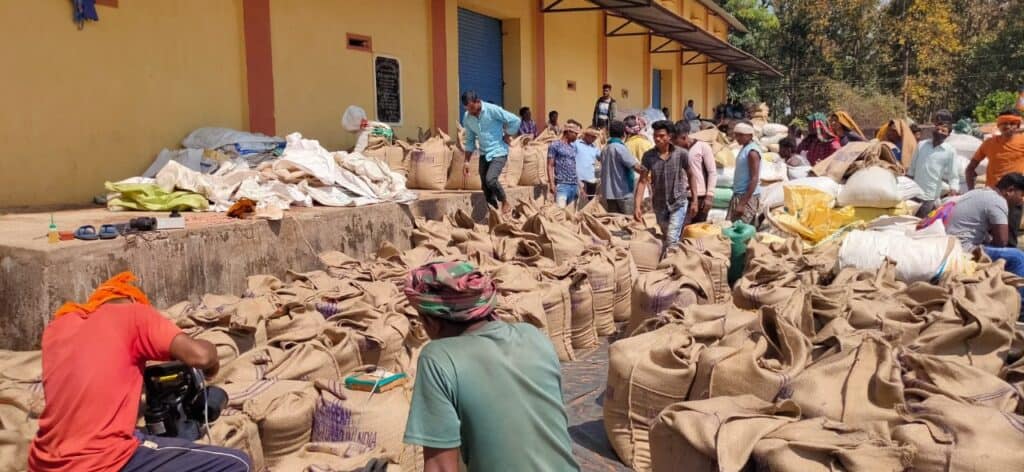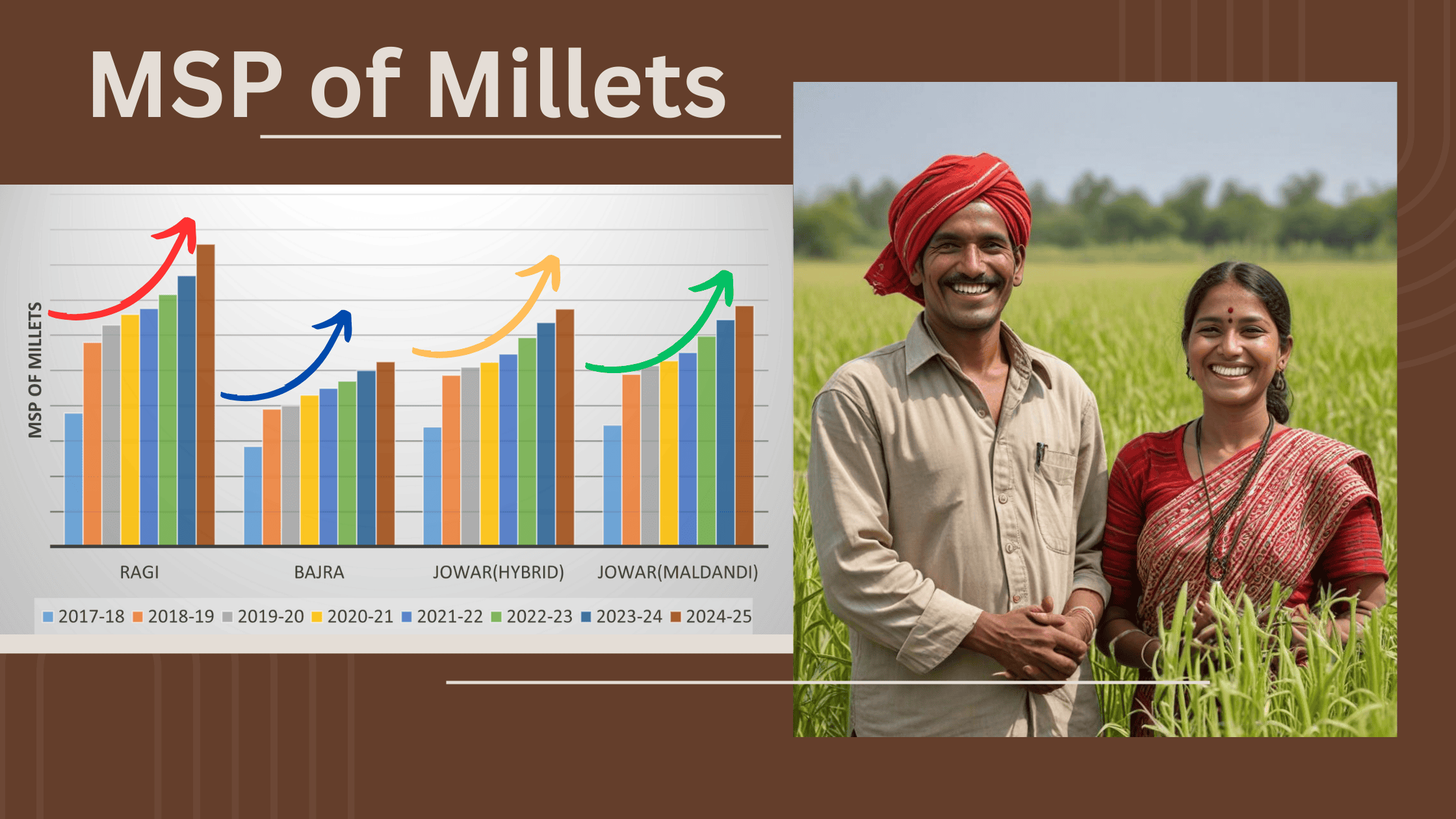Table of Contents
MSP of Millets:
Millets, the traditional superfoods of India, have been steadily reclaiming their importance in recent years. Packed with protein, fiber, vitamins, and minerals, these resilient and climate-friendly crops require less water and thrive in harsher conditions compared to rice or wheat. Recognizing their potential, the Indian government has taken a significant step by substantially increasing the Minimum Support Price (MSP) for millets for the 2024-25 crop year. This move is expected to bring renewed hope and financial security to farmers across the country.
Government’s Commitment to MSP of Millets:
The Union Cabinet, chaired by Prime Minister Shri Narendra Modi, approved the increase in MSP for all mandated Kharif crops for the marketing season 2024-25, based on the recommendation of the Commission for Agricultural Costs and Prices (CACP). The price adjustments of Millets are as follows:
- Ragi (Finger Millet) increased from Rs. 3846 to Rs. 4290 per quintal.
- Bajra (Pearl Millet) increased from Rs. 2500 to Rs. 2625 per quintal.
- Jowar (Hybrid) increased from Rs. 3180 to Rs. 3371 per quintal.
- Jowar (Maldandi) increased from Rs. 3225 to Rs. 3421 per quintal.
The MSP for Ragi (Finger Millet) has increased from Rs. 3846 to Rs. 4290 per quintal, reflecting a rise of Rs. 444. Bajra (Pearl Millet) has experienced a more modest increase, moving from Rs. 2500 to Rs. 2625 per quintal, which is an increment of Rs. 125. Jowar (Hybrid) has risen from Rs. 3180 to Rs. 3371 per quintal, up by Rs. 191, while Jowar (Maldandi) has gone from Rs. 3225 to Rs. 3421 per quintal, a difference of Rs. 196. These adjustments in MSP are designed to ensure better financial returns for farmers, encouraging them to cultivate these climate-resilient crops and contribute to a more diversified and sustainable agricultural system.

This hike is part of a broader strategy to make agriculture more remunerative and to encourage crop diversification. By offering a higher MSP of millets, the government aims to make millet cultivation a more attractive option for farmers, ensuring they have a reliable income source and are protected against market price fluctuations. The increase in the Minimum Support Price (MSP) for millets has been gaining strength steadily since 2018-19, reaching a significant mark in the 2024-25 marketing season.
Benefits for Small and Marginal Millet Farmers:
1. Financial Security and Increased Income
A higher MSP translates to a guaranteed minimum price for farmers’ produce, ensuring better returns and financial stability. This move is particularly significant for small and marginal farmers who are often most vulnerable to price volatility. With the assurance of a minimum price, farmers can plan their cultivation more effectively, invest in better inputs, and improve their productivity. This not only boosts their income but also contributes to the overall growth of the rural economy.
The increase in the Minimum Support Price (MSP) for Finger Millet has brought visible happiness among millet farmers in Odisha since 2018-19. Under the Odisha Millet Mission, the procurement of Ragi at the MSP has led to significant positive changes for the farmers.

2. Encouragement of Sustainable Agricultural Practices
Millets are known for their resilience and ability to grow in arid and semi-arid regions with minimal water requirements. They are also less susceptible to pests and diseases, reducing the need for chemical inputs. By promoting millet cultivation, the government is encouraging sustainable agricultural practices that are more in harmony with the environment. This shift towards millets can help conserve water resources, improve soil health, and reduce the carbon footprint of agriculture.
Impact on Rural Economy:
Increased income for farmers leads to higher spending in rural areas, benefiting local businesses and the overall rural economy. When farmers have more disposable income, they are more likely to invest in education, healthcare, and other essential services for their families. This creates a positive ripple effect, improving the standard of living in rural communities and contributing to the overall development of the country, India.
Nutritional Benefits for Consumers:
The MSP of millets hike is not just beneficial for farmers; it’s advantageous for consumers too. With increased production and better availability, millets are likely to become more accessible. This can encourage people to incorporate these nutritious grains into their diet, leading to a healthier and more balanced food culture in India. Millets are a rich source of essential nutrients and have numerous health benefits. They are gluten-free, have a low glycemic index, and are packed with antioxidants. Regular consumption of millets can help manage diabetes, improve digestive health, and boost overall immunity.
Strategic Move Towards Food Security:
The government’s focus on millets is a positive sign for the future of Indian agriculture. By supporting the cultivation and consumption of these wonder grains, we can ensure a more secure and sustainable food system for generations to come. This move aligns with the Union Budget 2018-19 announcement of fixing the MSP at a level of at least 1.5 times the All-India weighted average cost of production. This policy ensures that farmers receive a fair margin over their cost of production, making agriculture a viable and profitable occupation.
Final Thoughts on MSP of Millets:
The substantial increase in the MSP of millets is a significant step towards boosting the confidence and financial security of Millet farmers. By promoting the cultivation of these climate-resilient and nutritious crops, the government is ensuring a more sustainable and diversified agricultural system. This move not only benefits farmers but also consumers, leading to a healthier and more balanced food culture in India. As we embrace the return of millets, we are paving the way for a brighter and more secure future for Indian agriculture.
Although the Minimum Support Price (MSP) for millets has been approved at the national level, only a few states actively procure millets at MSP from farmers. Notably, Odisha has been procuring Ragi at MSP since the 2018-19 season. This proactive approach has provided substantial benefits to millet farmers in the state, ensuring better financial returns and encouraging the cultivation of this resilient crop.
It is imperative for all states to adopt similar procurement practices. By procuring millets at MSP, states can incentivize farmers to cultivate these nutritious and climate-friendly crops, thereby reversing the decline in millet cultivation that has been ongoing since the 1960s. State-wide procurement initiatives will play a crucial role in expanding the area under millet cultivation, ensuring food security, and enhancing the livelihoods of millet farmers across the country.
I hope this blog on MSP of Millets was helpful to you. At the end, I will request your thoughts on this. I will be happy to go through your feedback and suggestions.
Author: Tapas Chandra Roy, A Certified Farm Advisor on Millets, ‘Promoting Millets from Farm to Plate’ and an Author of the book -” Millet Business Ideas-Empowering Millet Startups”. In a mission to take the forgotten grains- Millets to Millions. To remain updated on my blogs on Millets please subscribe to my newsletter and for any queries please feel free to write to [email protected]


